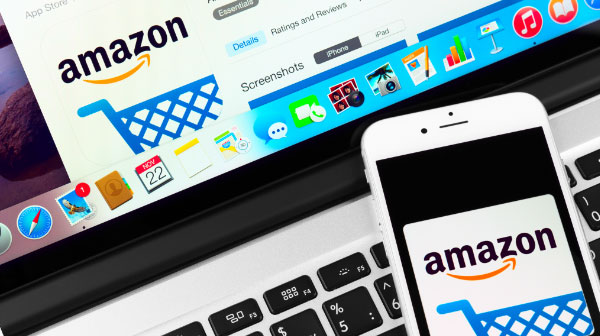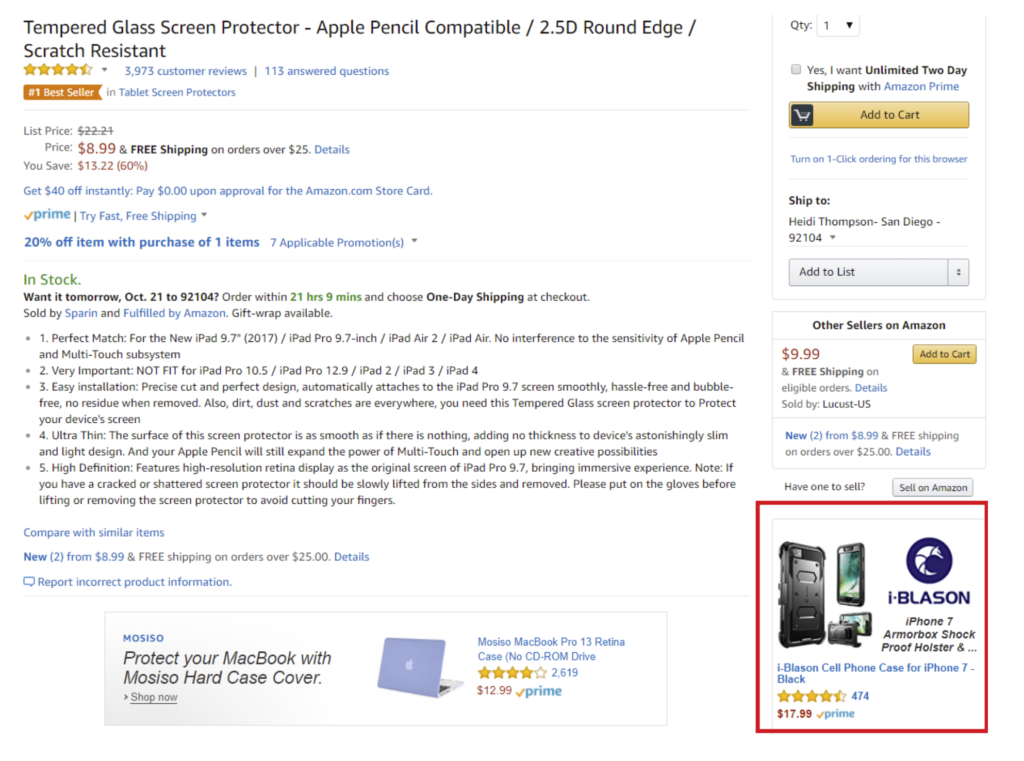
Amazon Sponsored Products are exciting and you may know that they can help you increase your sales but you may be hesitant to get started because it seems like such a steep learning curve. This article will bring you up to speed on how Amazon Sponsored Products work and how you can get started using them to make more sales.
What are Amazon Sponsored Products?
Amazon Sponsored Products are PPC (pay per click) ads that Amazon shows a customer when they search for a product. Sponsored Products look very much like search results and intermingle with them, which is a benefit of using them. In the screenshot below, you’ll see the gray text that says “sponsored” on each Sponsored Product.

How Amazon Sponsored Products Work
Sponsored Products use keyword-based targeting that is similar to Google Adwords. You can provide the keywords, or let Amazon find the keywords for you automatically. While this keyword-based targeting is technically similar to AdWords, Amazon uses a very different strategy and has different requirements.
With Amazon Sponsored Products you pay a per-click fee only when a shopper clicks your ad. When they click your ad, the shopper is taken directly to an Amazon product detail page, where the shopper can buy the product from you. It is not possible to use Amazon Sponsored Products to drive traffic to another website.
There are requirements to being in the Sponsored Products program. Before starting, be sure to read Amazon’s overview. Here are the basic requirements:
- An active Amazon professional seller account.
- Ability to ship to all US addresses.
- Product listings in one or more of the available categories.
- Products must be new. Used products are not eligible for advertising.
- Your product listings must be eligible for the Buy Box. If you create a Sponsored Products ad for a product listing that is not eligible for the Buy Box, your ad will not display to Amazon shoppers. Ads that are not eligible are flagged in Campaign Manager under the Advertising tab in Seller Central. Headline Search Ads will be shown to shoppers regardless of who is winning the Buy Box.
This Buy Box requirement may seem a bit odd because it is Amazon compounding the advantages of the Buy Box for sellers that are already dominant, rather than leveling the playing field and that can seem off-putting. This limitation does make sense though because if you were sending traffic to a product listing where you didn’t own the Buy Box, it is very likely you’d be paying for traffic for another seller.
Being part of the Sponsored Products program does not automatically get you the Buy Box. If you try to advertise a product and you don’t control the Buy Box, Amazon won’t run your ad and they will notify your campaign manager.
Your Targeting Options
Before we dive deep into targeting options, it’s important to know that there are two types of campaigns: auto and manual.
Auto campaigns are quick and easy to set up and run but can be hard to optimize because you don’t have much control. Amazon automatically guesses which keywords are best and uses those. Manual campaigns give you complete control over each part of the campaign and they take more effort to set up and optimize but provide a much larger opportunity to increase your profits.
In an auto campaign you have only four inputs that impact how the campaign runs:
- Daily budget
- Start & end dates
- Products advertised
- Default bid
Once you start an auto campaign, Amazon will guess which keywords are most relevant to the products in the campaign. When someone searches using one of those keywords, your ad will enter the ad auction with the bid you specified and if you win Amazon will show your ad. With manual campaigns you get to pick the keywords you target and you must set the match type and bid for each keyword. This gives you extremely precise control over the campaign.
Match type describes the relationship between your chosen keyword and the customer’s search term. It’s how you tell Amazon how closely related the search terms needs to be to your keywords in order for the ad to be shown.
It is important to note that the keyword is what you bid on while the search term is what the customer actually searched for in Amazon’s search box. If a customer’s typed search term triggers a keyword that you’re bidding on, then your ad will be entered into the auction. If it wins, your ad will be shown. You only pay if the customer clicks your ad.
There are three match types: Broad, Phrase, and Exact. When you set up a manual campaign you need to select the match type for each keyword to be either broad, phrase, or exact. If the keyword you’re bidding on is “frying pan”, here is how each match type would work.
- Exact match would include the search terms “frying pan” or “frying pans” only.
- Phrase match would include search terms like “frying pan” and “11 inch frying pan”.
- Broad match would include all of these search terms as well as broader ones like “frying pan cast iron”.
You can also use negative match to gain even more control over your campaign. Negative keywords allow you to tell Amazon that you do not want to bid on those search terms, even if they would normally trigger one of your keywords. Negative keywords come in exact and phrase varieties.
If for instance, you sell only 11, 13, and 15 inch frying pans, you could set up a broad match keyword for “frying pan” and a negative phrase keyword for “9 inch”. In this case, you will never bid in the auction when a customer searches for “9 inch frying pan”, even though normally it would have triggered the broad match keyword. This level of specificity allows you to show your ads only to those most likely to buy from you.
Many people ask if targeting for Amazon Sponsored Products incorporates information about the user the way Facebook Ads do. With Amazon Sponsored Products you can only target based on keywords so you don’t have the option to target by demographics like you do with Facebook. Of course if you’ve found particular keywords that work well for you on other platforms, it is worth testing them on Amazon to see how they perform.
Unfortunately, it is not possible to retarget people who have seen your Sponsored Product. Amazon sometimes run their own retargeting campaigns based on products people have viewed or added to their cart, but that is not a feature that is made available to sellers.
Tools for Managing Amazon Sponsored Products
All of the campaign management can be done with the Amazon interface but there are more advanced tools you can use to manage and optimize your campaigns.
Ignite – Seller Labs, the company behind leading Amazon seller tools Feedback Genius, Scope and Quantify, have released Ignite. It’s a complete and robust system for managing and optimizing Sponsored Products ads, replacing the need to use Seller Central, and adding innovative features to help sellers select the most effective keywords, analyze their performance and optimize their ad spend.
Pricing is based on the number of Ignite managed campaigns, which is defined as a grouping of automatic-targeted and manual-targeted campaigns for a product (or group of products) for which Ignite offers keyword suggestions and automatic bid adjustments. These prices currently range from $49-$499 per month.
Sellics – This tool is an all-in-one solution for Amazon sellers. It incorporates a profit dashboard, a PPC manager, ranking optimization, product research, inventory control, competitor monitoring, and review management. Sellics promotes their tool as the first and only PPC Manager that does not require any manual upload due to its full integration with Seller Central.
It allows you to stay on top of your PPC campaigns and track the performance of your ads for any given period, which you can analyze using the performance metrics of your choice (revenue, cost, CPC, ACoS, orders, etc.) Prices for this all-in-one tool currently range from $77-$499 per month.
PPC Entourage – PPC Entourage aims to make optimizing your Sponsored Products easier and less tedious. It allows you to find new profitable keyword opportunities based on existing campaigns, test new match types for existing keywords, remove poorly performing keywords, and reduce bid amounts to more profitable levels.
PPC Entourage also offer management services if you want to hand over the management of your sponsored products entirely. They also offer consulting, courses, and coaching so you don’t have to figure everything out on your own if you don’t want to. Prices for this tool currently range from $47-$247 per month based on number of SKUs.
Prestozon – Prestozon is all about using bid automation to optimize your Amazon ads in less time. Bid suggestions and automation help you effortlessly shift your money from bad keywords to profitable ones. Prestozon Bid Wizard adjusts bids to maximize exposure and minimize wasted ad spend.
You can use Prestozon’s Suggested Bids to quickly achieve the best possible ACoS for every keyword. You tell them your target ACoS for each campaign, and their proprietary algorithms will make bid suggestions to optimize toward that target. Prestozon also saves your bid history so you can make more educated decisions in the future. The cost for Prestozon Basic (Bid Wizard and Analytics) ranges from $27-$97 per month if you pay annually and including Automation will cost 1% of your ad sales.
How Much Do Amazon Sponsored Products Cost?
Each keyword in each ad group has a maximum bid amount. If you want to set a maximum bid per keyword, you can do that in a manual campaign. Otherwise, the maximum bid automatically inherits the default bid for that campaign.
Normal bids range from $0.20 for noncompetitive keywords to $2 for medium competitiveness to as high as $6 for extremely competitive keywords so your cost will vary based on how competitive your chosen keywords are on Amazon.
One metric that can help clarify how much you should spend to acquire an individual sale is the Average Cost of Sale, or ACoS. You will want to calculate your ideal Average Cost of Sales should be before you start your campaigns. To calculate your ACoS, take the selling price of the product and subtract your cost of goods, FBA fees, and any other miscellaneous costs. Here are some example numbers:
Selling Price: $27
Cost of Goods: $4
FBA Fees: $11
Miscellaneous Costs: $3
Using these numbers, you’d be left with $9 after deducting everything from the selling price. That means that you can spend up to that amount and still be profitable.
To calculate your ACoS threshold for your break-even point, simply divide the net income by the selling price ($9/$27=.33). This leaves you with a 33% ACoS threshold, meaning that you would be making money on any keyword that has a cost of sale at 33% or less. Amazon reports this number for each product but it is important to understand what it means so that you can make wise decisions about your Sponsored Products.
Sponsored Products vs Other Types of Ads
Within Amazon Marketing Services (AMS) you have these 3 types of ads to choose from:
- Headline Search ads
- Sponsored Product ads
- Product Display ads
Headline Search Ads
Headline Search Ads are typically best suited for the top of the sales funnel as they are best for branded and general category searches. These ads are always shown at the top of the search results page and feature a custom text headline along with several products, as shown below.

These ads are targeted by keywords, and are best for general search terms because they allow you to interact with a potential customer at the very beginning of their search – before they have narrowed down which product they want to buy.
Unlike other ad options, with Headline Ads you can decide where someone who clicks the ad lands. You can choose between your brand pages, product pages, search result pages or a custom URL (such as an original landing page). You can then specialize and hand-tailor ad campaigns and stray from the conventional. You can also choose the text and images in your ads as well. Aside from infinite creative possibilities, this also enables trial-and-error testing.
If you have a wide range of product types, want to promote a new product category, or simply want to show off more goods, this type of AMS ad offers the largest range. However, it is not without drawbacks. This is the least targeted campaign type and because the ad is only triggered on the right conditions, the ad appears sparingly and, overall, has a low click rate compared to other AMS ad types.
Sponsored Product Ads
As you’ve already learned, Sponsored Product ads have the unique strength of allowing both automatic and manual targeting. Automatic targeting is quicker and easier and a little cheaper in bidding but manual targeting gives you all of the power which can work wonders in capable hands.
These ads can appear in the top or bottom of search results, as well as on the right side rail, provided that you are currently winning the buy box. This campaign type is most similar to Google shopping because the ads are for a particular product, and Amazon takes into account your bid, product relevancy to the search term, and your sales history. These ads mimic search results and are intermingled with them which can result in a high click volume.
Sponsored Products ads do require you own the Buy Box and they will not run if you don’t. Of all three types of Amazon Marketing Services ads, Sponsored Product ads tend to have the highest cost per click but that does depend on what keywords you are targeting. The only available destination with these ads is the individual product page.
Product Display Ads
Product Display ads are shown only on product detail pages, below the add to cart button, and are the last chance to advertise to a potential customer before something is added to a cart.

With Product Display ads, you can choose specific product pages for your ads to show up on. These could be similar products, competitor’s products, or products that naturally work well together. You can also target products under the same interest group, ensuring your ad gets seen by people with the same passions as your target customers. The option to choose which product pages your ad appears on presents a lot of opportunities. This allows for a finer degree of shopper targeting that considers personal interests and product relations and it also allows for direct competitor targeting.
Like Headline Search Ads, Product Display Ads also allow fully customizable text and images. This means you can choose ad copy and images that point out your competitor’s shortcomings and how your product circumvents them.
The drawbacks of this ad type include low volume, higher cost per click, and the ability to only direct people to the product page as opposed to the more customizable destination available with Headline ads.
As you can see, all AMS ad types have pros and cons and choosing the best for you really depends on what your goal is for the campaign.
How To Get Started with Amazon Sponsored Products
In order to get started with Amazon Sponsored Products, go to Amazon’s overview page here. Amazon often runs promotions where you can get free credit toward your ads when you sign up so keep an eye out for those. You’ll find a lot of information in Amazon’s FAQ section but sometimes it’s easier to have a step by step guide to walk you through.
Sellics has created The Amazon PPC Complete Guide: How Pay Per Click Advertising Works on Amazon to help you get started.
Prestozon has also created a very in depth beginner’s guide to Amazon Sponsored Products.
CPC Strategy has a lot of resources for Amazon advertising but The Amazon Sponsored Products Guide and the on-demand webinar that comes along with it is an excellent resource for those wanting to get the most out of Amazon Sponsored Products.




